Fantasia 2019, Day 9, Part 2: J.R. “Bob” Dobbs and the Church of the Subgenius
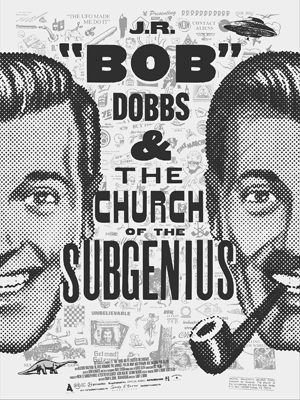 My second and last movie on July 19 was a documentary named for its subject: J.R. “Bob” Dobbs and the Church of the Subgenius (a film known in some quarters as Slacking Towards Bethlehem). Directed by Sandy K. Boone, it’s a history of a mock religion which got started more than 40 years ago, and still goes strong today.
My second and last movie on July 19 was a documentary named for its subject: J.R. “Bob” Dobbs and the Church of the Subgenius (a film known in some quarters as Slacking Towards Bethlehem). Directed by Sandy K. Boone, it’s a history of a mock religion which got started more than 40 years ago, and still goes strong today.
It was begun by two bright misfit young men in the late 1970s, when Douglas Smith AKA Ivan Stang and Steve Wilcox AKA Philo Drummond took on aliases and began writing satirical pamphlets outlining the gospel and worldview of the Church of the Subgenius. They swiftly developed a specific tone and weird doctrine, praising the figure of J.R. “Bob” Dobbs, a piece of 1950s advertising clip art. “Bob” (there must always be quotation marks around his name) represented a quality called ‘slack,’ which was never really defined except that it was a good thing to have; organised religions, by contrast, did not have slack. At any rate, the Church of the Subgenius developed a complex set of myths around gods, mutants, and aliens, and began selling their pamphlets through the mail. They came along at the right time to take advantage of zine culture as it developed through the 80s, and more and more people wrote away for their strange handmade tracts sending up the whole idea of mythology and religion. Live events followed, including annual “devivals” at which the end of the world is expected and awaited with joy. All the while the Church maintained its basic parodic aim and attitude, and, still in existence, keeps up that attitude in the face of an increasingly bizarre reality.
The movie tells us the story of the Church through a basically chronological structure. There are extensive interviews with Church members, especially the two founders. Ivan Stang is the more voluble, slightly manic with an odd edge, a recurring figure through the documentary that anchors the film. There are also interviews with well-known members of the Church, like Paul Mavrides, Alex Cox, Richard Linklater, and Penn Jillette. And there is a lot of archival footage, some of it taken by members of the Church and some of it footage from TV news shows showing baffled reporters trying to cover a Church event.
There’s a certain amount of care taken to explain to the wired world the zine subculture of the 1980s. The Church of the Subgenius took off in that context, reaching people who risked sending a dollar to a perfect stranger to get something weird in exchange. In the days before the internet, zines were a way for largely-bright and largely-young people to connect with each other, with the Church perhaps one of the odder examples of this alternative culture. Time having passed, it has also proved one of the longer-lasting.
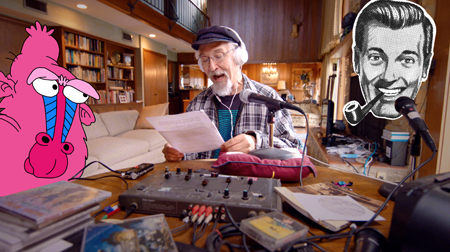 The documentary is therefore a depiction, and a good one, of intelligent antisocial young men in an era and situation that gave them few outlets. Both founders of the Church had straight and straightforward jobs in Texas; the Church was in part born out of dissatisfaction with their life and society, a way to mock the world around them and make fun of whoever they didn’t like. It turned out that across North America, in suburbs and small towns and elsewhere, there were a lot of people on the same wavelength: ironic, clever, perhaps a little angry or perhaps a lot. In those years, zines and the Church of the Subgenius gave those people an outlet.
The documentary is therefore a depiction, and a good one, of intelligent antisocial young men in an era and situation that gave them few outlets. Both founders of the Church had straight and straightforward jobs in Texas; the Church was in part born out of dissatisfaction with their life and society, a way to mock the world around them and make fun of whoever they didn’t like. It turned out that across North America, in suburbs and small towns and elsewhere, there were a lot of people on the same wavelength: ironic, clever, perhaps a little angry or perhaps a lot. In those years, zines and the Church of the Subgenius gave those people an outlet.
There is a discussion of women in the Church of the Subgenius, who were and are a distinct minority. One of the women describes the Church as a “boy’s club.” There’s a little discussion about race, less about the Church around the world. I personally might have liked to see a bit more consideration of these things, if only as a way of getting at the sort of personality that the Church attracted; but the film’s only 84 minutes, and it’s hard to fault it for choosing to focus on other things.
Along the same lines, though, it might have been useful to have a little discussion of some of the subcultural phenomena on the same wavelength that were often as it were comorbid with the Church: Discordianism, perhaps the Illuminatus! trilogy, other things that parodied the main culture in similar ways and had a similar attitude — and that seemed to overlap some aspect of the Church. But then again, a documentary has to determine what’s central to its subject. J.R. “Bob” Dobbs and the Church of the Subgenius does do that, and perhaps it’s wise to avoid going too far down certain rabbit holes.
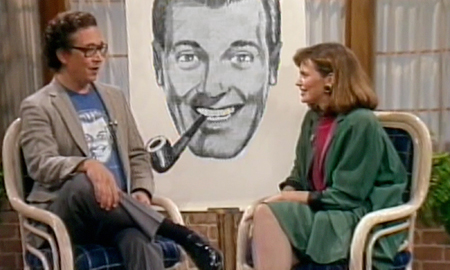 For example, the film does talk about the way some of the Church members took things further than Stang was comfortable with. It talks about the way the Church, like actual churches, makes a distinction between the ingroup and the outgroup; the Church is a lot more light-hearted than most, more like science-fiction fandom with its ‘mundanes,’ but here as elsewhere one runs into the problem of how to parody a thing without recreating it. Some of the more moving passages in the film come from Stang reflecting on this paradox, and fearing that for some people he did not mock religion but simply create yet another Church. By the end, we see him worrying that in some ways the Church of the Subgenius anticipated the rise of a Donald Trump.
For example, the film does talk about the way some of the Church members took things further than Stang was comfortable with. It talks about the way the Church, like actual churches, makes a distinction between the ingroup and the outgroup; the Church is a lot more light-hearted than most, more like science-fiction fandom with its ‘mundanes,’ but here as elsewhere one runs into the problem of how to parody a thing without recreating it. Some of the more moving passages in the film come from Stang reflecting on this paradox, and fearing that for some people he did not mock religion but simply create yet another Church. By the end, we see him worrying that in some ways the Church of the Subgenius anticipated the rise of a Donald Trump.
That strikes me as unlikely, not only given their relative popularity, but also given who they appeal to and how. J.R. “Bob” Dobbs and the Church of the Subgenius gives a strong sense of the Church and its history, but also makes it clear how much it was always a creature of the margins. That was the point. It is true that the creator of a religion, like the creator of any kind of art, can’t dictate how their creation will be perceived and used; but the relationship of the Church of the Subgenius to the deep belief in Trump seems clearly one of mockery decades ahead of time. If there’s an undercurrent of disgust at society in Trumpism, it’s hard to see it manifesting in the same way in the Church, at least in this documentary. The link to meme culture and a certain kind of message board culture is maybe stronger, in terms of who gets pulled in; still, the Church of the Subgenius seems to me, based on this film, more thoroughly anti-authoritarian. But to analyse the similarities and differences, again, would probably take an entire film in itself.
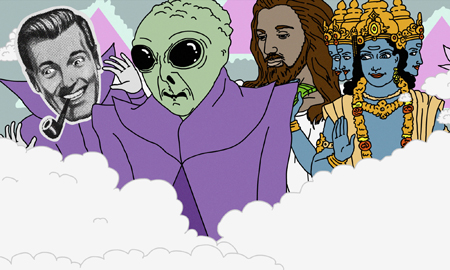 And in the end this film itself is strong work. As I said, the Church was always a creature of the margins, almost defiantly so, meaning there is a sense in which the documentary’s a deep probe of a shallow subject. But like most subjects, look deeply enough and you find a manifestation of something broader. The movie shows something of what it was like to be a bright misfit at a certain time, before it became easier to find a community through the internet, when the postal service was a key to weird and unknowable mysteries. If only for that sense of character interacting with society, the movie’s well worth watching.
And in the end this film itself is strong work. As I said, the Church was always a creature of the margins, almost defiantly so, meaning there is a sense in which the documentary’s a deep probe of a shallow subject. But like most subjects, look deeply enough and you find a manifestation of something broader. The movie shows something of what it was like to be a bright misfit at a certain time, before it became easier to find a community through the internet, when the postal service was a key to weird and unknowable mysteries. If only for that sense of character interacting with society, the movie’s well worth watching.
After the film, director Sandy Boon came out to take questions. The first was about her relationship with Bob, and how it came about. According to my scribbled notes, that began in her 20s, through her husband. She noted that many wives of Subgenius men had the real jobs in their families, as she did; the Church community loved her anyway. Asked if it was difficult to find people to interview for the documentary, she recalled being in Europe promoting another documentary when Trump was elected, and deciding then to do the Subgenius documentary she’d been talking about. At that point she was able to get people to sit for interviews relatively easily.
In answer to another question about dealing with VHS technology, Boone said that she found a number of Subgeniuses were amateur filmmakers. They’d used different media, all of which then had to be transferred to digital, and modern interviews dirtied up a little to fit. Asked about the current state of political trolling in the United States and why she didn’t connect the Church to modern trolls, Boone said (according to my notes) that she needed to make the documentary not a Texas film, observing also that the Church was huge in Europe. She wanted to show that the Subgenius practices were still used in the world. She spoke about the men in documentary who were raised in the 1950s, told they would be able to get good jobs, and how they coped with the Reagan years; the movie was thus inevitably political, and tied in to today.
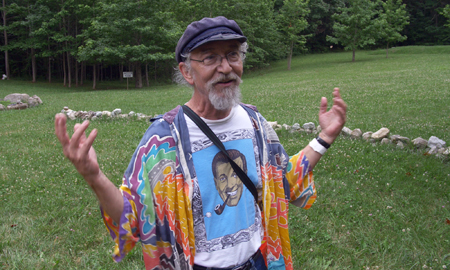 Asked about the collage effect the film created, Boone said it was a nightmare to assemble and to go through everything. This led her to note that the Church of the Subgenius does still exist and still thrives (Rupert Bottenberg, the Fantasia programmer who had introduced Boone and the film, and who is himself in the Church under the name of the Reverend Otis Jones, said it was 1$ to get in and 20$ to get out). Asked if the founders opposed the craziness of politics in the US today, she said yes, observing that Philo Drummond was a never-Trump conservative, which she did not know until she was ready to lock the movie. Asked what her hope was for the movie, she said she would like to see it become a kind of platform for younger people to use to talk about their political views.
Asked about the collage effect the film created, Boone said it was a nightmare to assemble and to go through everything. This led her to note that the Church of the Subgenius does still exist and still thrives (Rupert Bottenberg, the Fantasia programmer who had introduced Boone and the film, and who is himself in the Church under the name of the Reverend Otis Jones, said it was 1$ to get in and 20$ to get out). Asked if the founders opposed the craziness of politics in the US today, she said yes, observing that Philo Drummond was a never-Trump conservative, which she did not know until she was ready to lock the movie. Asked what her hope was for the movie, she said she would like to see it become a kind of platform for younger people to use to talk about their political views.
In answer to another question she said that ‘devivals’ still happen every July 5. Finally, asked if there was any connection to the Church of the Flying Spaghetti Monster, she said that the members knew each other and were all friends. The main difference was that the Church of the Flying Spaghetti Monster, like the Church of Satan, actually did activism promoting laws keeping church and state separate. By contrast, the Church of the Subgenius was just fun.
Find the rest of my Fantasia coverage from this and previous years here!
Matthew David Surridge is the author of “The Word of Azrael,” from Black Gate 14. You can buy collections of his essays on fantasy novels here and here. His Patreon, hosting a short fiction project based around the lore within a Victorian Book of Days, is here. You can find him on Facebook, or follow his Twitter account, Fell_Gard.
“If there’s an undercurrent of disgust at society in Trumpism, it’s hard to see it manifesting in the same way in the Church, at least in this documentary.”
I haven’t thought much about this movie — it was enjoyable and adequately informative–but I think that segment toward the end was intended more to fast-forward to the current world state and how the mainstream, by becoming a parody of itself so thoroughly, rendered the Church not so much unnecessary as no longer as pertinent.
It was something of a disappointment to me that the current political situation was brought up, but as a “Subgenius” citizen of the United States, I generally feel there are some things best left ignored for the time being in the hopes that, as a country, the US moves on to better days soon.
Unlike one of our confrères, I don’t think my country as being “evil” — just under bad management at the present. I worked an office job long enough to learn that sometimes the best thing to do with bad managers is ignore them until they get reassigned.
Was there an interview with Devo’s Mark Mothersbaugh?
Giles: I think there’s a good argument the Trump bits should have been either expanded or left out. To me the weird messianic fervour of Trumpism is difficult not to talk about in this context. So many people are so willing to twist themselves in knots justifying whatever he says that it starts becoming indistinguishable from the Subgeniuses coming up with ridiculous dogma just for the sake of being ridiculous.
I mean, I’m currently expecting a wave of editorials arguing that nuking hurricanes is perfectly sensible, actually; and up to few years ago I’d really only have associated that kind of weirdness with something like the Church of the Subgenius. So it may be worth mentioning. Or to put it another way: was the Church always parodying the same kind of mentality that put Trump in office? If so, is that something central to the US? I think these are worthwhile questions for this film. But like I say, you may be right that it needed to spend more time on them.
Adrian Simmons: I don’t remember Mark Mothersbaugh being in it, but Gerald Casale was. Now, I’m not especially a Devo fan, so I wouldn’t have noted Mothersbaugh if he was in it. I can say there certainly was mention of Devo and how they paralleled the Church and grew interested in it.